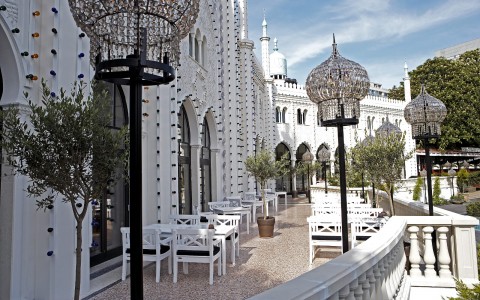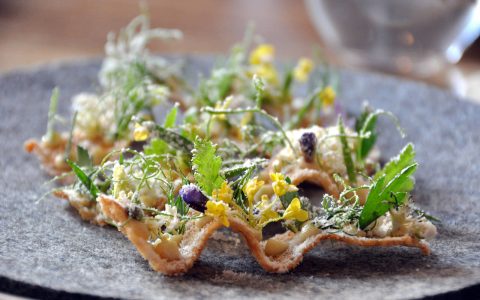What We’re Drinking:
Rioja’s Reds and Danish Akvavit
Our motto has always been “Slow Down to See the World”—but “Slow Down to Sip the World” would be almost as accurate. Whether we’re sampling a Burgundian wine or silky Japanese sake, we believe one of the best ways to learn about a region is through its libations.
We tapped writer and wine expert Dick Snyder to introduce you to two very different but equally delectable drinks: akvavit and the reds of Rioja.
Akvavit – Scandinavia
 What It Is
What It Is
Akvavit (aka aquavit or akevitt) is basically the Scandinavian version of gin—but not quite. It’s a distilled spirit made in a manner similar to gin, but it tastes nothing like it, flavoured principally by caraway, along with botanicals such as dill, fennel, citrus peel, cumin and anise.
Akvavit has been produced since the 15thC and is legally required to have a minimum 37.5% alcohol. Its taste can vary from delicate to complex spice and faint citrus, and the colour may range from clear to yellowish to light brown. Clear akvavit is called taffel.
Where it Comes From
This delicious aperitif is Scandinavia’s contribution to the world of spirits. Danes and Swedes make theirs out of wheat or barley; it is not traditionally aged and is usually clear. Norwegians, on the other hand, opt for a distillate based on the humble potato, and are known to age their akvavit in previously used oak sherry casks.
When/How to Drink It
In Scandinavia, akvavit is traditionally enjoyed at social gatherings and festivities such as Christmas and weddings. Consume this aperitif at the beginning of a cocktail party and throughout appetizers to excite the palate and help digestion.
Usually served very cold and sipped from shot glasses, Swedes and Finns traditionally pair it with crayfish parties in late summer. Short on crayfish? Opt for Scandi dishes like gravlax, smoked fish and pickled herring, along with rye bread, pungent cured meats and pickles. Aged versions from Norway may be served at room temperature in tulip-shaped glasses.
Why We Love It
What’s not to love? For one thing, it can be hard to find outside of Europe, so it’s an exciting change of pace to enjoy before dinner with your salty snacks. And since drinking from a shot glass is generally frowned upon post-college, here’s a built-in excuse to get a little wild.
There’s really no other spirit like it, so it’s fun to pull a bottle out of the freezer and show off to your friends that your palate extends beyond the usual beer, wine and whisky.
Did You Know?
In recent years, modern micro-distillers are jumping on the akvavit tradition and making their own localized versions of the spirit. The Newfoundland Distillery Co. makes it with locally produced barley, honey, peat, juniper and herbs.
Rioja Wine – Spain
 What It Is
What It Is
Not a grape, or even a style of wine, Rioja is a region of Northern Spain, called La Rioja by the locals. Today, the wines are riding a wave of popularity, in part because they represent considerable value. Quality in the region has gone up, and the styles of wine reflect this—from traditional to contemporary.
An influx of French winemakers in the late 1860s—who fled the vine-killing epidemic phylloxera that decimated France—influenced the local style. Under the French, most of whom were Bordelais, the wines were made to be aged and to exhibit the spice-and-smoke influences of oak barrels.
Across the board, these wines are delicious, rich and spicy, with distinct vanilla-coconut and violet tones. Older Gran Reservas are outstanding food wines while young Jovens and Crianzas are perfect patio sippers. They’re pretty much all red, made predominantly from the Tempranillo grape. Some white Riojas do exist, but are harder to find.
Where It Comes From
Three distinct regions contribute to Rioja wines: Rioja Alevesa, Rioja Alta and Rioja Baja. Though many wines are a blend of grapes from all three areas, you will find bottles labeled with specific origin as well.
Very generally, it’s said that Alta makes wines of higher quality and in an old world style, while Alevesa produces wines with more body. Baja enjoys the influence of the Mediterranean, and the wines are often higher in alcohol and deeply coloured.
Where, When and How to Drink It
Wines from Rioja are remarkably distinct. The Tempranillo grape lends its flavours—a spicy grape with red and black berry fruit, floral tones, and bright acidity—which combine with the influence of oak and ageing.
Basic-level Rioja might see little to no aging. A crianza wine will have one year in oak, and have a barely distinguishable hint of spice and smoke. From there, it’s all about ageing and oak influence, with Reserva (one year in oak and two in bottle) and cellar-worthy Gran Reserva (two years in oak and three in bottle, only produced in the best vintages) among the most formidable of the world’s full-bodied and expressive wines.
These special-occasion wines are perfect for big meaty dishes, especially a local specialty of lamb grilled over vine cuttings, or holiday dinners and roasts. They’re warming wines for chilly evenings, when your home is full of friends and the table is full of delicious things.
Why We Love It

Rioja wines taste and look great. Ornate old-world bottles are even a tad Gothic, while contemporary brands can get whimsical with their graphics. And even better, due to the various levels of ageing and oak—they’re remarkably versatile.
A young un-oaked wine makes a great aperitif, while a smoky Gran Reserva plays beautifully with game and rich stews. (You could drink Rioja all night and still feel like you’ve been around the world and back.)
Tip
It’s simple: you get what you spend on Rioja. That is to say, they are consistently good wines across the board. And when you drop an extra bit more on a special bottle, you’ll taste that difference. (Just don’t drink the good stuff out of tumblers—big Bordeaux glasses only, please!)
MORE FROM Europe + Denmark

What We Love About Denmark
Denmark
My Favourite Restaurants & Bars in Copenhagen
Denmark
5 Cycling Trips Destined to Be Classics
Denmark


